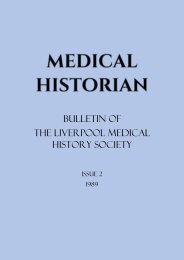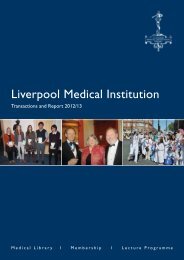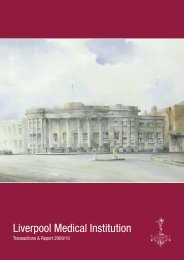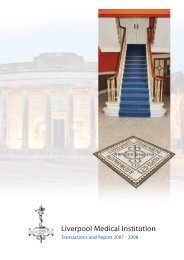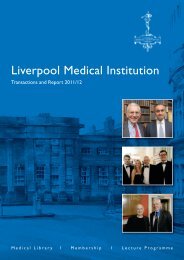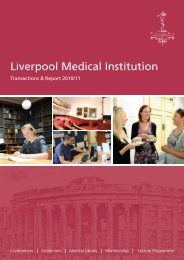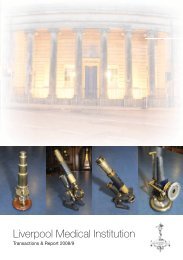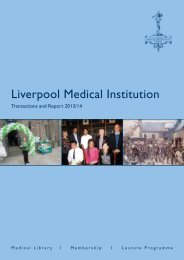LMITransactions&Report2014-15
Create successful ePaper yourself
Turn your PDF publications into a flip-book with our unique Google optimized e-Paper software.
LMI Transactions and Report 2014 - 20<strong>15</strong><br />
ethical principles regarding human experimentation<br />
developed for the medical community by the World<br />
Medical Association.<br />
The presentation will seek to inform the audience<br />
about what led to the Nuremberg Trials - and invite<br />
them to reflect on whether it is unethical to use<br />
information gained from Nazi experiments, or if to<br />
ignore it would mean millions of people ‘died for<br />
nothing’.<br />
Sophie Gealy-Evans - Runner-Up<br />
‘Anaesthesia in the First World War’<br />
Anaesthetics is now considered an essential part of<br />
medicine, but in 1914 it was a game of trial and error.<br />
The First World War was a brutal massacre of life, for<br />
which both soldiers and medical professionals were<br />
severely unprepared. There was a sudden<br />
advancement in anaesthetic techniques in this period<br />
(1914-1918), during which a massive need for pain<br />
relief and emergency treatment resulted in the<br />
established role of the anaesthetist. Out of the<br />
desperation came innovative new ways to deal with<br />
casualties and poor facilities.<br />
I believe there were three key elements that were<br />
outcomes of the harsh conditions of war - the role of<br />
the anaesthetist, the development of anaesthetic<br />
agents and their administration and the better<br />
understanding of the physiology behind them. In this<br />
presentation, I would like first to give some<br />
background on what was already known about<br />
anaesthetics at the time, and then consider how each<br />
of these three aspects developed, and why the War<br />
was so integral in their progression.<br />
On the year of its centenary, it is especially important<br />
that we recall how this war shaped and moulded<br />
these three elements, and I will consider how the<br />
setting of World War I was both a catalyst, and<br />
limiting factor, to the advancements of anaesthetics,<br />
which shaped the course of new advancements. It<br />
should be remembered whilst looking at new<br />
developments in the war zone that these must be fully<br />
explored and adapted to civilian life, away from the<br />
limitations of combat, so that positives can be taken<br />
from the horrific situations from where they came. I<br />
believe it is a topical subject, and an educational way<br />
to pay respect to those who died during the First<br />
World War.<br />
22




